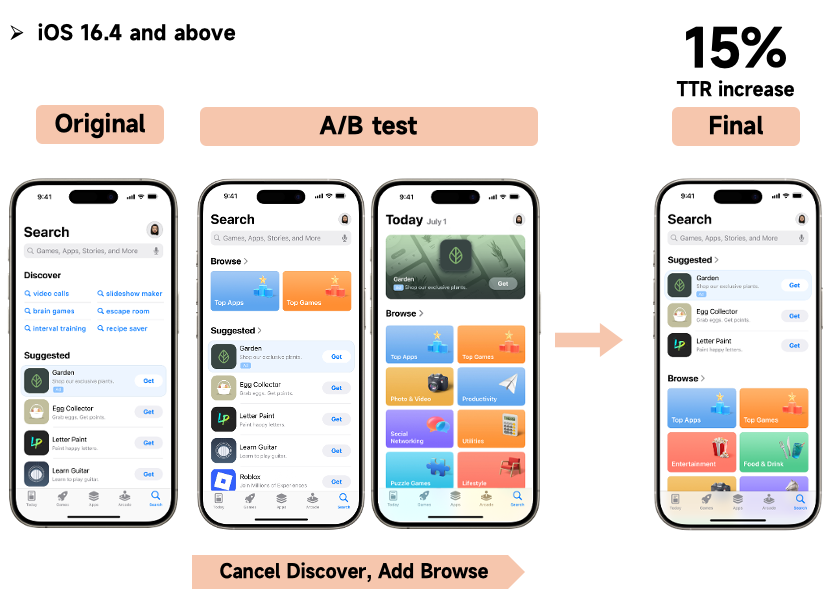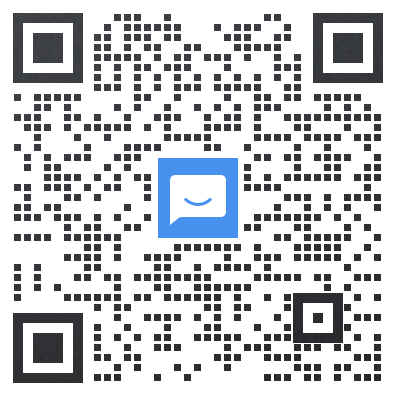In recent months, Search Tab ads have undergone a deep rework to deliver an efficient and precise ad placement. BrightLake’s long-term tracking and testing show that this revamp has led to a clear performance boost, with Tap-through rates (TTR) surging by 15%1 and significant gains in user acquisition.
The current window of opportunity during this opportunity for Search Tab Ads is critical. To help every developer seize this opportunity, Brightlake’s performance breakdown of the upgraded Search Tab Ads, along with best practice insights.
1. Ad Placement Revamp
The latest upgrade to Search Tab Ads is nothing short of a deep rework. On the outer layer, the App Store’s Search page went through several rounds of A/B testing. The final design version is shown below.

At the top half of the screen, only two apps are recommended at a time, alongside one Search Tab Ad. The lower half features colorful card-style app list entries designed to keep users browsing longer.
Search Tab Ads now support Custom Product Pages (CPPs) as landing pages, making it easier to carry traffic from the ad into a tailored experience and improve conversion rates.
CPPs now support deeplink allowing developers to guide users directly to specific in-app destinations, ideal for boosting engagement or promoting events.
2. TTR increase by 15%
According to case studies, the upgraded Search Tab Ad format drove nearly a 15%1 increase in TTR and installs without raising average cost per acquisition (CPA) .
Previously, due to its simple structure, Search Tab Ad was favored by well-known apps with strong brand equity, which were willing to invest heavily to capture share of voice and intercept user traffic even before a search was initiated. Other apps typically only used this placement during launches, brand campaigns, or major promotions.
But since the upgrade, average TTR in daily campaigns has jumped by 15%. And now, Custom Product Pages (CPPs) offer strong downstream support to absorb that traffic. For high-quality but lesser-known apps, this is a chance to win purely through great content.
The current window of opportunity following the Search Tab upgrade is critical—and one every developer should act on.
When Custom Product Pages were added as variants to search results ads, we saw standout creatives with high TTR get rewarded with more traffic. The same applies for a well-crafted CPP on Search Tab can lift conversion rates and reduce acquisition costs.
When looking to acquire new users, reinstalls, or activate your existing base, this ad-placement deserves more investment and strategic attention.
3. Best Practices for Search Tab
Running ads in the Search Tab isn’t as simple as launching one campaign and calling it a day. Success in this placement requires real effort across three key areas: timing control, competitive analysis, and creative optimization. Based on hands-on testing and campaign experience, the best practices and common mistakes for Search Tab ad campaigns.
- Time slot:
Aligning ad schedules with industry-specific peak times can significantly improve tap-through rates and conversion rates.
During low-search periods (late night), TTR typically drops 5%–10% below average. In contrast, during peak hours, TTR can rise by 5%–10%. Increasing bids and spend during high-TTR time frames allows the system to learn and deliver more stable traffic at lower cost over time2.
While working within a limited budget, it is recommended to loosen budget caps and raise bids during peak hours to capture more traffic, and tighten spending during off-peak times.
For precise time-based delivery, consider working with Apple Ads partners like BrightLake, whose SaaS platforms allow for advanced schedule control and optimization.
Competition
Understanding the regional and time based competition is better for ad strategy. Take US market as an example, app categories and bidding strategies competing in the Search Tab vary significantly across different times of day.
To optimize CPA effectively, you need to continuously monitor market dynamics and adjust your bidding and campaign strategies accordingly.
This requires strong market insight, experience with different categories, and the ability to adapt to shifting conditions.
Creative Assets
Accurately targeting user needs, aligning with brand identity, and localizing creatives are key to maximizing conversion rate. But there are two major pitfalls to avoid:
A. When creating ad creatives, it’s essential to ensure they align with users’ existing perceptions and expectations of the brand.
When designing ad creatives, ensure they match users’ expectations and brand perception. If users click through and find content that feels disconnected from the brand or overly focused on a niche feature it can reduce conversion rates by 2%–3%3. That’s why Custom Product Pages should align closely with your app’s overall design language and branding style.
B. When targeting other regions, not localizing the App Store product page may result in the system pausing ad delivery.
Before Custom Product Pages were introduced to Search Tab Ads, ads could run freely across all regions without restriction. However, with CPP now required, if your product page and metadata are not localized, your ads may be paused or blocked for not meeting the language version requirements of the target market. You can check the default language versions required for each promotional region through Apple’s official website : https://developer.apple.com/help/app-store-connect/reference/app-store-localizations
Following this upgrade, Search Tab ads which are known for combining brand impact and performance have truly maxed out their effectiveness on the acquisition front. This marks a major boost for well-known apps seeking substantial growth, and an exceptional overtaking opportunity for high-quality, niche apps.
Data sources:
- Based on 2025 ad placement data from BrightLake, compared to the same app’s average performance during the same period in 2024.
- Based on BrightLake’s 2024 full-year data on Search Tab ad placements, compared with average results.
- Based on 2025 BrightLake ad data compared to 2024 conversion rate data before custom product pages were supported for the same app.



